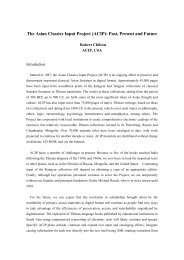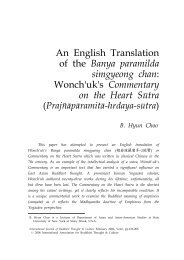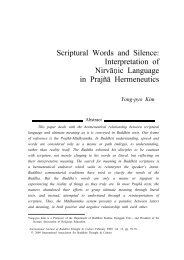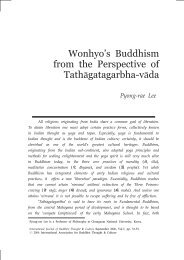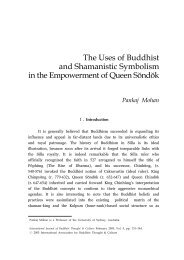Esoteric Buddhism under the KoryÅ in the Light of ... - Buddhism.org
Esoteric Buddhism under the KoryÅ in the Light of ... - Buddhism.org
Esoteric Buddhism under the KoryÅ in the Light of ... - Buddhism.org
You also want an ePaper? Increase the reach of your titles
YUMPU automatically turns print PDFs into web optimized ePapers that Google loves.
64<br />
Henrik H. Sørensen: <strong>Esoteric</strong> <strong>Buddhism</strong> <strong>under</strong> <strong>the</strong> Koryŏ<br />
“he success <strong>of</strong> every great <strong>under</strong>tak<strong>in</strong>g <strong>of</strong> our state depends upon <strong>the</strong><br />
favour and protection <strong>of</strong> Buddha.” 13 Bear<strong>in</strong>g <strong>in</strong> m<strong>in</strong>d that this is <strong>the</strong><br />
open<strong>in</strong>g words <strong>in</strong> <strong>the</strong> political bequest <strong>of</strong> <strong>the</strong> fo<strong>under</strong> <strong>of</strong> <strong>the</strong> dynasty,<br />
<strong>the</strong>y hardly need any elaboration. It is <strong>of</strong> course an open discussion to<br />
what extent this seem<strong>in</strong>gly strong relationship actually played any role<br />
<strong>in</strong> matters <strong>of</strong> “Real-politik,” but it rema<strong>in</strong>s a fact - at least dur<strong>in</strong>g most<br />
periods <strong>in</strong> <strong>the</strong> dynasty’ history - that Koryŏ politics and <strong>Buddhism</strong> were<br />
<strong>in</strong>deed closely entw<strong>in</strong>ed. There is no need to argue whe<strong>the</strong>r <strong>the</strong> Koryŏ<br />
k<strong>in</strong>gs were able to rule without <strong>Buddhism</strong>, as it never happened,<br />
<strong>the</strong>refore it will make more sense to try to <strong>under</strong>stand how <strong>the</strong> system<br />
<strong>of</strong> mutual benefit for ruler and religion actually worked <strong>in</strong> practice.<br />
Ritual practice is at <strong>the</strong> heart <strong>of</strong> <strong>Esoteric</strong> <strong>Buddhism</strong>, hence it<br />
should come as no surprise that most <strong>of</strong> <strong>the</strong> historical records on that<br />
tradition <strong>in</strong> <strong>the</strong> Koryŏ actually deal with rituals. Given that our ma<strong>in</strong><br />
historical sources for <strong>the</strong> Koryŏ are <strong>the</strong> Koryŏ sa 高 麗 史 (The History <strong>of</strong><br />
<strong>the</strong> Koryŏ Dynasty; hereafter KS) and <strong>the</strong> Koryŏ sa chŏ ryo 高 麗 史 節 要<br />
(The Essentials <strong>of</strong> <strong>the</strong> History <strong>of</strong> <strong>the</strong> Koryŏ Dynasty; hereafter KSC) it<br />
is <strong>in</strong>evitable that <strong>the</strong> documentation found <strong>the</strong>re<strong>in</strong> is both terse and<br />
brief to <strong>the</strong> po<strong>in</strong>t <strong>of</strong> be<strong>in</strong>g note-like. Never<strong>the</strong>less, <strong>the</strong> <strong>in</strong>formation on<br />
Buddhist rituals provided by both sources is quite substantial, <strong>in</strong> fact it<br />
is <strong>the</strong> most dom<strong>in</strong>ant type <strong>of</strong> <strong>in</strong>formation on <strong>Buddhism</strong> we encounter <strong>in</strong><br />
<strong>the</strong>se historical works. When compared with Ch<strong>in</strong>a and Japan, we f<strong>in</strong>d<br />
that <strong>the</strong> number <strong>of</strong> Buddhist rituals performed by and for <strong>the</strong> Koryŏ<br />
court, i.e. <strong>of</strong>ficial rituals or state rituals, was noth<strong>in</strong>g short <strong>of</strong><br />
stagger<strong>in</strong>g. 14 For both historical and cultural reasons, Buddhist rituals<br />
performed at <strong>the</strong> bequest <strong>of</strong> <strong>the</strong> Song court decreased greatly as <strong>the</strong><br />
dynasty wore on, partly due to <strong>the</strong> rise <strong>of</strong> Neo-Confucianism, whereas<br />
Buddhist rituals cont<strong>in</strong>ued to be part and parcel <strong>of</strong> dynastic and div<strong>in</strong>e<br />
legitimacy <strong>in</strong> Imperial Japan up to <strong>the</strong> Meiji Restoration <strong>in</strong> <strong>the</strong> second<br />
half <strong>of</strong> <strong>the</strong> 19th century. Even so, <strong>the</strong> reported occurrences <strong>of</strong> Buddhist<br />
13 Op. cit., p. 363.<br />
14 For a lengthy article on <strong>the</strong> nature <strong>of</strong> <strong>Esoteric</strong> Buddhist rituals <strong>under</strong> <strong>the</strong> Koryŏ, see Sørensen<br />
(Forthcom<strong>in</strong>g, 2007).



